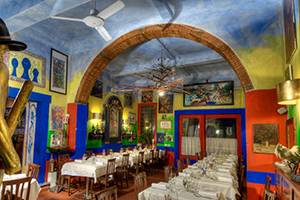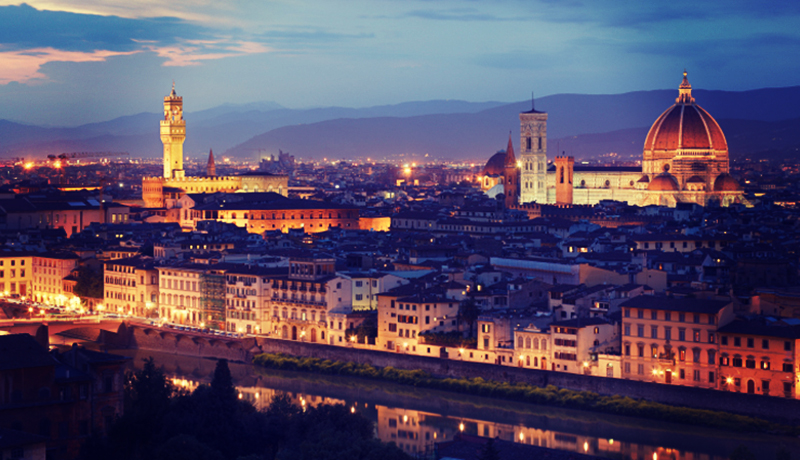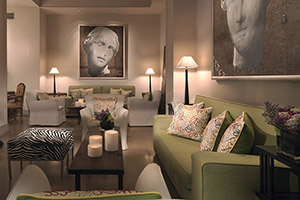
Forty-eight hours in Florence may not feel like much, but it’s enough time to find your footing and see most of the main sights. Don’t feel hindered by a strict itinerary, however; often, the best Florentine experiences come from the discoveries you make during your walks between the biggies.
For style, luxury and location when it comes to lodging, you can’t beat the sleek Forbes Travel Guide Five-Star Hotel Savoy. With limited time in the Tuscan capital, easy access to all neighborhoods and attractions is key: the Savoy stands tall in Piazza della Repubblica, the most central point of the city. It’s mere seconds from Florence’s famous cathedral and within walking distance of all major monuments. Post-exploring and pre-dinner, indulge in a cocktail at Irene, the hotel’s super-chic bistro.
Day One
Hands down, the best way to get to know Florence is on foot. Upon arrival, exit the hotel to the right and you’ll quickly end up in Piazza del Duomo, where you can marvel at the recently restored Baptistery and the key icon of every Florentine postcard, Filippo Brunelleschi’s dome. But don’t linger here for too long — the cathedral square is captivating, but it’s often chaotic and crowded. Venture instead up Via Martelli, which will lead you toward the San Marco Museum. Once a convent, this hushed space is never overrun with tourists, despite being home to a collection of Fra Angelico masterpieces, a famed Michelozzo-designed library and the spiritual retreat of Cosimo de’ Medici the Elder.
If you could use a time-out from art and museums, take the long, leisurely walk to the city’s Left Bank for a more bohemian side of local life. The Oltrarno is Florence’s famed artisan district, home to countless boutiques, design studios, coffee and cocktail joints. Grab a gelato at neighborhood spots like Gelateria La Passera (opt for the fruitier flavors) or Santa Trinita (sample the signature Black Sesame option), then relax with some prime people-watching and window-shopping.
Clotheshorses can comb through the selection at well-curated shops such as Celeste Vintage and Ceri Vintage. Map junkies and memento hunters should scoot to the lively Sdrucciolo de’ Pitti, a street sandwiched between Piazza Santo Spirito and the Pitti Palace. If you’ve got tykes in tow, the wax models at the zoological and natural history museum La Specola are worth a stop — you’ll probably have the place to yourself.
When hunger strikes, don’t head straight for dinner — do as the locals do and embrace the aperitivo hour. Beginning around 6 p.m., most area bars, from mom-and-pop coffee places to hip literary cafés, serve cocktails with complimentary snacks, varying from bowls of nuts to full-blown buffets. Neighborhood hotspots (with plentiful spreads) include Cabiria and Tamero’, both in Piazza Santo Spirito. Save room for a classic, unfussy Tuscan dinner at homey spots like Trattoria Casalinga or Trattoria dell’Orto.
On the walk back to the Savoy, cross Ponte Santa Trinita to enjoy a nighttime passeggiata (walk) down the always-pristine Via Tornabuoni, home to numerous flagship fashion boutiques and the towering Palazzo Strozzi, Florence’s largest temporary exhibition space.
Day Two
In Piazza della Repubblica, you have your pick of historic cafés for an Italian-style breakfast. Morning coffee and cornetto at the neighborhood bar is a sacred ritual. Knock back an espresso at Giubbe Rosse, known as a former literary haven and key component of the Futurist movement.
Fuel up well for a morning with Michelangelo. David, the Renaissance master’s magnum opus, is one of Florence’s must-sees, but waiting in line all morning at the Accademia and viewing it with little background won’t be worth your while. Instead, well ahead of your trip, book a “Michelangelo in Florence” walk with Context Travel, an in-depth but accessible exploration of his artistic legacy in Florence and beyond. The tour will put David and other works in a broader framework, shedding light on the Renaissance, the Medici and Florentine history as a whole.
Non-touristy dining options near the Accademia are scarce, but Osteria dell’Ortolano is a safe and tasty bet. For extra atmosphere and a wider variety of choices, make your way toward the San Lorenzo neighborhood and stop in at the Mercato Centrale. Before 2 p.m., take in the market action downstairs, where spices and Italian slang permeate the air in equal measure. All day long, the vibrant “first floor” (accessible by escalator) hosts a sophisticated, Italian-style food court of sorts, home to high-quality restaurants and food stands, and often hosting events and live music.

La Cucina del Garga, Photo Courtesy of La Cucina del Garga
Carefully consider your afternoon options: the Uffizi is one of the most renowned museums in the world, but rushing through it without advance research or a qualified guide is rarely worthwhile. Time should allow you to go in-depth at the Basilica of Santa Croce. Known as the Temple of Italian Glories, this Franciscan church is the burial place of Michelangelo, Machiavelli and Galileo, just to name a few. The sparse yet striking Pazzi Chapel, found in the first cloister, is a rare example of Renaissance architecture that’s remained largely unmodified through the centuries.
To end your Florentine adventure on a culinary high note, head to La Cucina del Garga in Via San Zanobi for Tuscan cuisine with a twist. Founded by charismatic butcher-painter Giuliano Gargani (“Il Garga”) and still run by his family, this colorful haunt brings together all the best of Florence: art, fresh food and international appeal.


